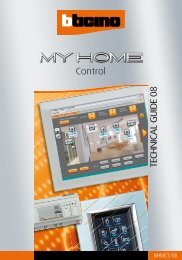NO - BTicino - Online Catalog
NO - BTicino - Online Catalog
NO - BTicino - Online Catalog
Create successful ePaper yourself
Turn your PDF publications into a flip-book with our unique Google optimized e-Paper software.
■ TRADITIONAL SYSTEM<br />
A traditional electrical system with features of<br />
high flexibility, which is easily configured and<br />
expanded as a function of the many different<br />
needs of the user is characterised by great<br />
circuital complexity and so structured that each<br />
function refers to separate and dedicated wiring.<br />
This clearly involves a considerable increase<br />
in installation time and may be a limitation in<br />
modifying or adding new functions when working<br />
in existing buildings. The problem of laying large<br />
amounts of wire, which in some cases implies<br />
considerable masonry work, should not however<br />
be underestimated.<br />
■ TRADITIONAL SYSTEM<br />
In a building made with traditional wiring, commanding two<br />
different lights from several points implies the laying of a<br />
considerable number of conductors.<br />
The addition, then, of a new command point inside the same<br />
box considerably increases the complexity of the wiring and<br />
reduces the room inside the box itself.<br />
■ BUS SYSTEM<br />
The solution to the system problems described<br />
is represented by the new digital technologies<br />
which can replace traditional equipment by<br />
“intelligent” devices which can communicate with<br />
each other.<br />
Each device in fact has an intelligent circuit which<br />
can process information and send it to the other<br />
devices.<br />
The means of transmitting information<br />
between the various devices is called a BUS,<br />
and in practice it is made up of a plaited pair<br />
which simultaneously supplies and exchanges<br />
information between the various devices<br />
connected in parallel.<br />
■ BUS SYSTEM<br />
The same room instead, wired with BUS wiring, can obtain<br />
the same operating functionality, but with a considerable<br />
saving in conductors (just a telephone pair).<br />
Modification of the command points or the modes of working<br />
does not involve modifying the wiring but just the simple<br />
configuration of the same device.<br />
GENERAL GENERAL FEATURES FEATURES 17<br />
MY HOME GUIDE GUIDELINES



